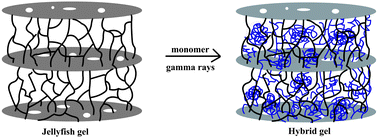Jellyfish gel and its hybrid hydrogels with high mechanical strength†
Abstract
The fabrication of hydrogels with well-defined structure and high mechanical strength has become a challenging and fascinating topic. The aim of this study is to develop a new method for fabricating hydrogels with high mechanical strength by utilizing the well-developed structure of biological gels. We firstly studied the mechanical properties and microstructure of a biological gel—the mesogloea of edible jellyfish Rhopilema esculenta Kishinouye (


 Please wait while we load your content...
Please wait while we load your content...